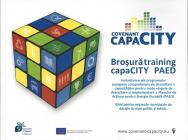
CO2 calculator, Bulgaria
The CO2 calculator developed by EAP is a software tool to support local authorities in translating the types of fuel used by the local authorities into energy and CO2 units. It covers hard and liquid fuels. Its emission factors are based on the national requirements and are periodically updated.

Long-range Energy Alternatives Planning System (LEAP), Bulgaria
LEAP (Long-range Energy Alternatives Planning System)- software tool for energy policy analysis and climate change mitigation assessment. LEAP is an integrated, scenario-based modeling tool that can be used to track energy consumption, production and resource extraction in all sectors of an economy.

Covenant capaCITY SEAP training tool
Capacity building of local government to take action regarding climate change and energy sources - from planning and action monitoring - is the primary goal of this tool. Capacity Covenant assumes development of communities powered by renewable energy across Europe. This support helps create chains of added value at regional level through improving energy efficiency and using renewable local energy sources.

System for monitoring and verification - SMIV, Croatia
SMIV is the first Monitoring and Verification Platform developed as an online application that incorporates National Energy Efficiency Action Plans, Regional and Local Energy Efficiency Action Plans and planning instruments together with specially devised tools that allow all users to generate reports, plans and calculations of their energy savings under the same unified methodology, defined by EU principles. Data contained in SMIV is used for many energy savings calculations, analysis and continuous overview of achieved National energy efficiency targets.

Analyses and recommendations for local budgets with aim of encouraging energy efficiency projects, Croatia
The research topic of this Guidebook is the adjustment of the local budgets in order for them to become supportive of the energy efficiency projects in public services. The main goal of the research was to provide suggestions and recommendations based on analysis of the current situation in Croatia and the comparative review of the experience of selected countries.

The Francilian Energy Bill, France
Tool developed within the framework of the Ile-de-France region's support missions on improving regional energy knowledge, to better understand data on consumption and production of energy.
This new indicator developed by the ARENE translates energy consumption data into monetary data (euro), in order to analyze the economic impact of energy consumption.

PlanETer, France
Project PlanETer (territorial energy planning). This R&D project has been funded with The Ark Energy program of the Foundation for innovation in the Valais.
The developed tool is intended to provide local decision-makers, technology of systems of Geographic Information (GIS), a vision global and systemic municipal area from the perspective of the consumption of energy and the availability of local energy resources.

Handbook for energy efficiency project implementation in local and regional government, Croatia
Handbook provides a classification of the energy efficiency projects in the budgets of local and regional government. It describes the process of preparation of energy efficiency projects, their implementation in the budgets of local and regional governments. Additionally, it provides examples of good practice energy efficiency projects funded by local and regional governments.

11 energy-saving assessment methodologies, Bulgaria
11 energy-saving assessment methodologies are used to assess the amount of energy saved as a result of the implementation of specific energy efficiency measures. They include a mechanism to allocate energy savings to each year of the lifetime of the measure concerned.

Energy calculator, Hungary
On- line calculator - Tool for energy audit with possibility to calculate payback period. The calculator is on Hungarian language, according to the Hungarian energy efficiency targets. You can input the type, size and material of the building, heating system, lighting, heating system, annual energy and water consumption and other parameters to calculate the payback period for investment in new equipment.

